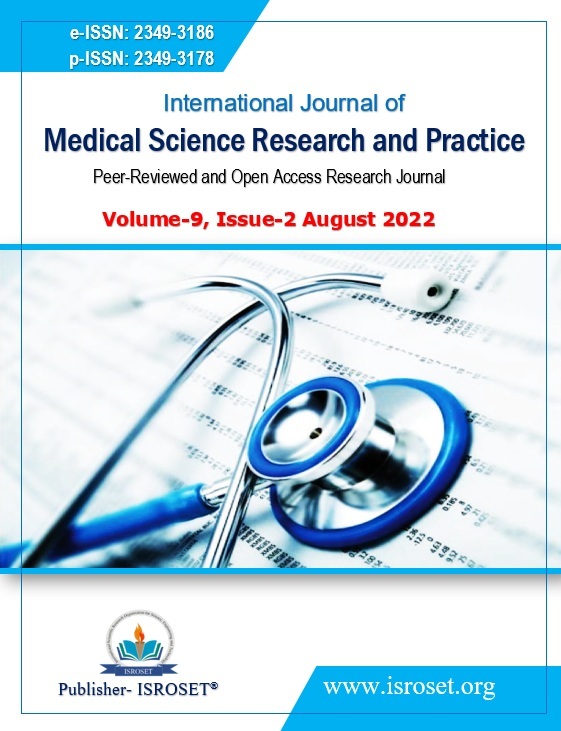Computation Studies on potential anti-COVID-19 natural compound against The Omicron Variant of SARS-COV-2
Keywords:
Covid-19, Adapalene, Docking analysis, SARS-COV-2Abstract
For the first time, this short communication aims to carry out the possible antiviral role of a natural compound called Adapalene. This substance has been shown, by the Molecular Simulation method, to be particularly active both in the original SARS-COV-2 protein and in the mutated form Spike protein of SARS-CoV- 2 Omicron (B.1.1.529). The best results obtained have reported excellent Binding Energies Scores values of about -10.35 kcal/mol with an estimated Ki of about 26 nMolar, when Adapalene interacts in the binding active zone of the receptor binding domain (RBD) of SARS-COV-2, with the Human ACE2. Furthermore, this compound can interacts also with other antiviral Coronavirus proteins. Indeed it can bind with other SARS-COV-2 proteins such as SARS-COV-2- 3Cl protease, with an Estimated Binding Energy of approximately, ca -10.24 kcal/mol and an estimated Ki of ca 31.15 nMolar, while with Nucleocapsid Phosphoprotein SARS-COV-2, with a Binding Energy of approximately of ca -10.47kcal / mol and an estimate Ki of ca 21.06 nMolar.
References
Shree, P., Mishra, P., Selvaraj, C., Singh, S. K., Chaube, R., Garg, N., Tripathi, Y. B.” Targeting COVID-19 (SARS-CoV-2) main protease through active phytochemicals of ayurvedic medicinal plants–Withania somnifera (Ashwagandha), Tinospora cordifolia (Giloy) and Ocimum sanctum (Tulsi)–a molecular docking study", Journal of Biomolecular Structure and Dynamics, Vol.40, Issue.1, pp.190-203,2022.
Sharma, A., Vora, J., Patel, D., Sinha, S., Jha, P. C., Shrivastava, N.”Identification of natural inhibitors against prime targets of SARS-CoV-2 using molecular docking, molecular dynamics simulation and MM-PBSA approaches",Journal of Biomolecular Structure and Dynamics, Vol.40, Issue.7, pp.3296-3311, 2022.
Das, S., Sarmah, S., Lyndem, S., Singha Roy, A.” An investigation into the identification of potential inhibitors of SARS-CoV-2 main protease using molecular docking study", Journal of Biomolecular Structure and Dynamics, Vol.39, Issue.9, pp. 3347-3357,2021.
Tahir ul Qamar, M., Rehman, A., Tusleem, K., Ashfaq, U. A., Qasim, M., Zhu, X., Chen, L. L. “Designing of a next generation multiepitope based vaccine (MEV) against SARS-COV-2: Immunoinformatics and in silico approaches", PloS one, Vol.15, Issue.12, pp. e0244176,2020.
Elfiky, A. A.” Ribavirin, Remdesivir, Sofosbuvir, Galidesivir, and Tenofovir against SARS-CoV-2 RNA dependent RNA polymerase (RdRp): A molecular docking study",Life sciences Vol. 253, pp.117592,2020.
Basu, A., Sarkar, A., Maulik, U. Molecular docking study of potential phytochemicals and their effects on the complex of SARS-CoV2 spike protein and human ACE2. Scientific reports, 10, Issue.1, pp.1-15, 2020.
Mpiana, P. T., Tshibangu, D. S., Kilembe, J. T., Gbolo, B. Z., Mwanangombo, D. T., Inkoto, C. L.,Tshilanda, D. D. “Identification of potential inhibitors of SARS-CoV-2 main protease from Aloe vera compounds: a molecular docking study", Chemical Physics Letters, Vol.754, pp.137751, 2020.
Bharadwaj, S., Dubey, A., Yadava, U., Mishra, S. K., Kang, S. G., Dwivedi, V. D.” Exploration of natural compounds with anti-SARS-CoV-2 activity via inhibition of SARS-CoV-2 Mpro",Briefings in bioinformatics, Vol.22, Issue.2, pp.1361-1377,2021.
Ngo, S. T., Quynh Anh Pham, N., Thi Le, L., Pham, D. H., Vu, V. V. “Computational determination of potential inhibitors of SARS-CoV-2 main protease” Journal of chemical information and modeling, Vol.60, Issue.12, pp.5771-5780,2020.
Pettersen, E. F., Goddard, T. D., Huang, C. C., Couch, G. S., Greenblatt, D. M., Meng, E. C., Ferrin, T. E. (“ UCSF Chimera—a visualization system for exploratory research and analysis”. Journal of computational chemistry Vol. 25, pp.1605-1612, 2004.
Trott, O., and Olson, A. J. “AutoDock Vina: improving the speed and accuracy of docking with a new scoring function, efficient optimization, and multithreading”. Journal of computational chemistry Vol.31 pp.455-461, 1010.
Huey, R., Morris, G. M., Forli, S. “Using AutoDock 4 and AutoDock vina with AutoDockTools: a tutorial. The Scripps Research Institute” Molecular Graphics Laboratory Vol.10550, pp.92037, 2012.
[13] Snyder, E. M., Johnson, B. D. “ACE2 and COVID-19: using antihypertensive medications and pharmacogenetic considerations", Pharmacogenomics, Vol.21, Issue.10, pp.695-703,2020.
[14] Liu, M., Wang, T., Zhou, Y., Zhao, Y., Zhang, Y., Li, J. “Potential role of ACE2 in coronavirus disease 2019 (COVID-19) prevention and management”, Journal of translational internal medicine, Vol. 8, Issue. 1, pp. 9-19,2020.
[15] Zhang, X., Li, S., Niu, S. ACE2 and COVID-19 and the resulting ARDS. Postgraduate medical journal, Vol.96, Issue.1137, pp.403-407,2020.
[16] Luan, J., Lu, Y., Jin, X., Zhang, L. “Spike protein recognition of mammalian ACE2 predicts the host range and an optimized ACE2 for SARS-CoV-2 infection", Biochemical and biophysical research communications, Vol.526, Issue.1, pp.165-169,2020.
Downloads
Published
How to Cite
Issue
Section
License

This work is licensed under a Creative Commons Attribution 4.0 International License.
Authors contributing to this journal agree to publish their articles under the Creative Commons Attribution 4.0 International License, allowing third parties to share their work (copy, distribute, transmit) and to adapt it, under the condition that the authors are given credit and that in the event of reuse or distribution, the terms of this license are made clear.






